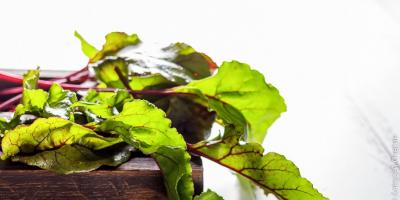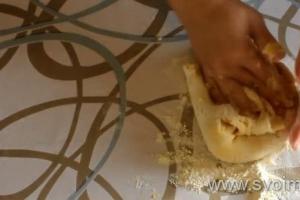The word “tops” in modern Russian has a somewhat derogatory connotation: this is what they call something insignificant and of no interest. This opinion did not arise out of nowhere: if beet roots have many culinary uses, they are used to prepare, and even, not much inferior to the classic one, then beet tops are often sent straight to waste. I demand an end to discrimination against beet tops! Beet leaves are a real superfood, rich in folic acid and other nutrients, and if they are fresh and not very large leaves, then after a short processing they will also be very tasty.
What to cook from beet tops? Well, at least here’s a side dish that can be whipped up in 5 minutes while the family is setting the table. Various greens are served in approximately the same way in some places in Italy, and in our country, if you think about it, it is not at all necessary to limit yourself to beet tops alone. Spinach, cabbage, and just other leaves of edible plants that you are about to throw away can also be prepared in a similar way - and it will be a delicious side dish that even staunch conservative meat-eaters will be happy with.
Beet tops side dish recipe
A delicious side dish of beet tops will be ready in 5 minutes. It is healthy (beets are rich in folic acid) and will appeal to even staunch conservatives.
Alexey Onegin
Sort through and thoroughly wash the beet tops, trim the lower part of the stems. Place a large saucepan of water over high heat, add a spoonful of salt, bring to a boil, add the beet tops and blanch for 2 minutes. Drain and place the tops in a bowl of ice water to retain color, then pat dry in a salad dehydrator or simply with paper towels.

Pour into a small frying pan, add thinly sliced garlic and a little ground pepper, and heat over low heat for several minutes. The garlic should impart flavor to the oil, but not darken.
Remove the pan from the heat, add the blanched beet tops and stir thoroughly until the oil coats each leaf.

Transfer the contents of the skillet to a plate or salad bowl, season with ground black pepper, drizzle with lemon juice if desired, and serve warm as a side dish or light dinner.
You know, I haven’t liked beets since childhood! Remember, in kindergarten and school they gave several round beets in a plate, brrr, what disgusting it was! Of course, the understanding that beet dishes are good for the heart, liver, eyes and that it contains fiber, vitamin C, copper, phosphorus, magnesium and sugar comes at a fairly late age. Well, who thinks about this in childhood or youth, right?
I consciously fell in love with beets after it became my favorite salad. Oh, I could (and still can) eat only it. On some holiday or birthday, I always chose a place closer to the plate with this salad and enjoyed the taste. By the way, beets go perfectly with herring, you can’t imagine anything better!
What other recipes for salads with beets do you know (I’m even trying to include them all in a separate article for convenience)? No less traditional and simple beet salad with garlic and mayonnaise is a classic of the genre. Well, although to be honest, before I started working on this site, I didn’t try it, but then suddenly it became interesting how it was beets and prunes, but I must admit, I liked it! You can also add nuts and chicken to this salad.
It’s clear with salads, I’ll move on to soups. This is not borscht for me! And the secret to preparing delicious borscht is that frying should be done together with cooking the meat. On a small, small fire, immediately add beets, onions, carrots and tomato paste (it is recommended to cook beets this way with some sourness, you can pour a little apple cider vinegar so that they retain their color). - this is absolutely fantastic.
This year I tried it for the first time. I was impressed by the taste, a soup like okroshka, only with beets. You can make it vegetarian, without meat, or you can add chicken. Very light, you can eat it cold in the summer with half an egg and sour cream, just yum-yum :)
Over the course of the year, I have collected a whole collection of new recipes for beet dishes that I have not tried yet, the most delicious and memorable dishes:
|
This recipe seemed very unusual to me, because inside it is still the same herring, which goes well with beets. The result is a festive salad that is convenient to eat by placing one of these beetroot balls on a plate. It’s simple to make: beets are mixed with cheese, yolks and mayonnaise and only then balls are rolled out of this mass. |
|
|
|
I made it like this in a mold, it turned out to be a festive version and, most importantly, it’s very tasty! |
 |
I was surprised to find that here is the link for the salad recipe. It is simple, but quite tasty and interesting. |
Beets are often combined with garlic or wild garlic in appetizers, and in desserts with raisins, honey and nuts. Beetroot dishes are very tasty!
Most gardeners perceive beet tops as waste that must be removed after harvesting. In fact, green leaves are a valuable source of nutrients and can be used as raw materials for canning. To get delicious preparations for the winter, just find out what recipes with beet tops exist.
Beetroot is a universal type of garden crop, as leaves and roots are used for food. Several centuries ago, only the tops were used for food, and the underground part was intended only for medical purposes. Today the situation is exactly the opposite and, mainly, root vegetables are used for food, and leaves, at best, are used to feed livestock. This situation deprives a person of a valuable source of vitamins and nutrients.
Beet tops contain a large amount of vitamins; they contain folic acid, which is necessary during the period of conception and gestation. When consuming leaves, a person is able to fill the body with a huge list of chemical elements, including phosphorus, calcium, magnesium, iodine and zinc.
Doctors advise including beet tops in your diet if you have the following problems:
- pathologies of the cardiac system;
- violation of the elasticity and patency of blood vessels;
- disruptions in the functioning of the endocrine system;
- anemia, problems with blood composition;
- stomach ulcer, gastritis.

Regular consumption of tops helps normalize metabolism and improves blood circulation, which has a beneficial effect on a person’s well-being. Due to the presence of choline in the greens, positive changes in the functioning of the liver are observed, since the active element prevents the formation of fatty deposits.
Improvements in the functioning of the digestive system occur thanks to pectin, which blocks the action of harmful intestinal bacteria.
An excellent replacement for fresh herbs are winter preparations, which allow you to obtain a valuable product during the cold period; a person has the opportunity to enrich the diet with tasty and healthy dishes at any time. Canned beet tops can be used as a snack, as an addition to side dishes, as a dressing for soups or as a salad ingredient.

Preparing the main ingredients
For salads and fresh use of tops, it is recommended to collect early leaves, as they become tough during the harvest period. The workpiece can also be made from late tops, but in order to soften it, heat treatment is carried out. For harvesting, choose cloudy weather without rain. If the vegetables were fed with nitrates, then it is necessary to cut off 5 centimeters of the cuttings at the base, this is where their accumulation is observed.
After collection, the leaves are thoroughly washed, excess debris and greens with obvious signs of damage are removed. To make the process easier, you can put the tops in a bowl of water for a couple of minutes; all small specks and light foreign objects will float up, so they can be easily removed.

Recipes for preparing preparations for the winter
Today there are many options for using beet tops. Gardeners often eat fresh greens in salads and add them to soups. An equally common method is drying leaves and freezing them. To preserve the qualities of the plant in winter, use:
- pickling;
- pickling;
- canning.
When choosing a cooking recipe, it should be taken into account that heat exposure reduces the value of the product. At the same time, hot preservation methods provide beet tops with the longest possible storage.

Dressing for borscht
It is not difficult to prepare a dressing for borscht, and in the future its use significantly saves the cooking time of the soup. The preparation can be used not only as an ingredient in a dish, but also as a regular salad.
The recipe involves the use of the following components:
- beets - 1 kilogram;
- water - 200 milliliters;
- tops - 500 grams;
- onions, heads - 1 kilogram;
- carrots - 1 kilogram;
- tomatoes - 1 kilogram;
- salt - 1.5 tablespoons;
- sugar - 1 tablespoon;
- vinegar 70% - ½ teaspoon.

First, pour a little sunflower oil into the pan, fry the carrots and onions until the vegetables become soft. After this, add beets, add water and simmer for 15 minutes. Add tomatoes and sugar and keep in simmer mode for another 10 minutes. Add salt and vinegar and mix the mixture thoroughly, keeping it on the fire until the beets are ready. Lastly, add the tops, leaving to simmer for 5 minutes. After boiling, the mixture is placed in sterilized jars.

Canned red beet tops
Beet leaves, for further use in borscht, can be prepared in just a few minutes, which is why the method is called “five-minute”. The leaves are cut, placed tightly in jars and filled with hot salty solution.
Salt and sugar are used to taste; the standard proportion is when 2 to 1 proportions are used per 1 liter of water and vinegar is added in the amount of ½ teaspoon. Canning involves sterilizing jars for 5 minutes. Vinegar is added to containers immediately before closing them.

Pickled leaves, petioles
You can pickle leaves and cuttings of beets. Since the structure of the parts of the plant is different, different processing of raw materials is assumed. For a recipe for 1 jar of 0.5 liters you will need:
- petioles 250 grams or 200 grams of beet leaves;
- salt - 1 teaspoon;
- sugar - 0.5 teaspoons;
- garlic - 1 clove;
- horseradish - 2 centimeters;
- allspice, black pepper - 5 and 10 pieces each;
- vinegar 70% - 1 milliliter.

The petioles are prepared using the triple-pouring method, that is, the hot marinade is poured, drained, boiled and re-poured 3 times. The leaves are prepared by sterilization, that is, the hot marinade is poured into jars and containers and boiled in water for 5 minutes. The blanks covered with lids are turned over and wrapped in a warm blanket.
Pickled
The method involves the use of tops. The recipe requires the following ingredients:

- stems - 1 kilogram;
- garlic - 1 piece;
- salt - 1 tablespoon per liter of water;
- bay leaf - 2 leaves;
- pepper - 10 peas.
The stems are doused with boiling water and placed tightly in jars, garlic and peppercorns cut into slices are placed between the layers, and salt is poured over the top. If you want to get the finished product in a week, then pour boiling water over the workpiece, keep it at room temperature for 2 days and put it in the refrigerator. If you fill it with cold water and put it in a cold cellar, the result is achieved after 3 weeks.

In Armenian
Beet tops prepared in Armenian style are called “borani”. Prepared from the following products:
- beet tops - 1 large bunch;
- onion - 1 head;
- garlic - 1 clove;
- salt, herbs, sour cream are added to taste;
- butter.
Finely chopped onions are sautéed in oil to achieve a golden hue. After this, add chopped tops and simmer under a closed lid for 15 minutes, add salt and pepper, during the process you need to periodically stir the mixture. Prepare the sauce by mixing chopped garlic with sour cream and thoroughly whisking with herbs. The dish is served simultaneously with the dressing.

Pickling
Salting allows you to preserve the tops with the maximum content of nutrients and vitamins. To do this, green leaves are cut and placed in dense layers of 2 centimeters in transparent containers, alternating with salt. The recipe requires coarse grinding without iodine content.. If the tops are too rough and hard, then first pour boiling water over them and wait until they dry.
The preparation for storage is put into the refrigerator and used directly when preparing the dish. To eliminate the risk of increased salt content in the finished dish, it is recommended to first add the dressing, and only then, if necessary, add additional salt.

Freezing
An excellent alternative to traditional dressings is the freezing method. The advantage of this option is the minimum required time, the possibility of long-term storage and preservation of useful substances, which is associated with the absence of thermal effects. You can freeze the product in the following ways:
- in plastic bags;
- containers;
- in the form of ice cubes.

Before freezing, washed beet tops are doused with boiling water, which makes them softer and more pliable. After drying, the greens are placed in bags from which excess air is removed. This action will ensure better storage of the product and save space in the freezer.
Beet tops can be stored separately from other greens or you can create a combination of herbs. Good “partners” for her are parsley and dill. This storage option is ideal for preparing soup dressings, as it allows you to form portioned bags or cubes for 1 use.

Tops appetizer
You can roll up beet stalks with pepper; this combination will be an excellent appetizer for the table. If the tops are tender, then there is no need to treat the stems with boiling water. Tough shoots are doused with hot water or boiled for 1 minute. For the recipe you will need:
- tops - 0.6 kilograms;
- salt - 1.5 teaspoons;
- wine vinegar 6% - 60 milliliters;
- garlic - 3 cloves;
- sweet pepper - 3 pieces.

The petioles are cut into 10 centimeters in size and placed in sterilized containers with sliced peppers, adding garlic evenly. You should not compact the layers too tightly. Add salt on top. The water is heated to boiling water and carefully poured into the jar to the level of the hanger. Add vinegar and sterilize for 10 minutes, then cover with lids and leave to cool.
How to properly store workpieces
Prepared delicious preserves can be considered half the job done, but it is no less important to preserve the preparations in the winter. The average shelf life of closed cans is considered to be 1 year, but the presence of a preservative in the form of vinegar in the composition allows you to increase this period.

You can store containers in the refrigerator, but, in most cases, choose cellar conditions, since a large number of cans can be stored in such a room. The key to long-term storage is the tightness of the containers and the temperature regime, which for preservation should be from 3 C to 15 C.
Before sending to the cellar, the jars should be checked for leaks; containers with the workpiece should be removed if droplets appear. These tops can be used for immediate consumption. It is not rolled up a second time, since with repeated heat treatment it loses its qualities, and the absence of such a procedure will not allow long-term storage of the workpiece.

If we rank vegetables according to their taste and usefulness for the human body, then beets will rightfully take first place, because beets effectively strengthen the body, increase hemoglobin, improve digestion and metabolism, increase immunity, and allow you to fight many diseases. Man has long noticed the healing properties of beets, which is why no kitchen in the world can do without this wonderful vegetable. And in our kitchen there are also many dishes made from beets. On this page I have collected my favorite beet dishes. I hope you enjoy them and make them often.
Beets are used not only for making borscht, beet soup and salads, they are baked, stuffed, made into health drinks, etc. But all these dishes will turn out tasty and at the same time healthy if and only if the beets are correctly selected and properly prepared.
- How not to make a mistake when choosing beets? Anyone who lives in a village knows very well that not all beets are the same, that there are fodder beets that are grown to feed livestock. There are sugar beets, from which sugar is obtained. And there is another one - table beets, which are used for cooking. It is the latter that should be chosen.
- We choose small root vegetables of rich beet color with a diameter of no more than 15 cm. The approximate weight of such beets is 450-500g.
- Small round beets, as a rule, are always sweeter and tastier.
- The beets should be quite firm, and when cut, uniform in color and without pronounced dense fibers. The light color and iridescent fibers indicate that you are looking at fodder beets.
- The fastest way to boil beets and at the same time preserve as much as possible the vitamins and all the beneficial properties of the root vegetable: boil the beets in their skins for 30-35 minutes, and then transfer them to ice water, or even with ice. When the beets have cooled completely, remove from the water.
- Store boiled beets in the refrigerator in their peels.
- Peel the beets immediately before preparing salad or other dishes with beets.
- You can also bake beets, but set the oven temperature to no higher than 180C. At higher temperatures, the vegetable loses its beneficial properties. Bake until done. Approximate time 40-45 minutes depending on the size of the root crop.
- When baking beets in a microwave oven, there is no need to talk about preserving vitamins. Convenient, but not healthy, and the taste leaves much to be desired.
We all love beets for their unique, unlike anything else taste and a lot of useful properties. It is most valued for the prevention of heart and vascular diseases, as well as anemia: beets are rich in substances such as iron, potassium and magnesium, which have a beneficial effect on hematopoietic processes in the body.
Unfortunately, we are accustomed to thinking that cooking beets is long and tedious: indeed, if you simply place them in a pan with cold water, they will cook for 2 to 3 hours, which cannot repel anyone who values their time from this product .
We decided to collect the most effective tips on how to cook whole beets as quickly as possible and at the same time preserve all of their unique beneficial properties.
Temperature changes
This method is ideal for those who decide to quickly cook whole beets in a pan.
If you urgently need boiled beets to prepare a dish, we advise you to act like a professional chef: leave them in boiling water for half an hour, drain the water and immediately place them under running ice water.
Leave the beets to cool under water for 10–15 minutes: such a sharp temperature change will bring them to readiness.
Boiling water
Bring the water to a boil and, placing the beets in the pan, cook for about 40 minutes, maintaining high heat. Pour plenty of water, because the high temperature will boil it away very quickly.
Big fire
To quickly cook beets on the stove, you will need high heat and 20 minutes of free time.
It is very important to pour in more water: the root vegetables should be covered with about a ten-centimeter layer of already boiling water. Otherwise, the water will boil away long before the beets have time to cook. Leave the pot on and simmer for 15-20 minutes, then run the root vegetables under ice-cold running water for 5 minutes. The beets are ready.
The only drawback of this express method is that nothing of the beneficial vitamin C remains in the product.
Baking in the oven
Try cooking beets quickly in the oven using an ovenproof bag. This method is as fast as cooking, and, most importantly, just as (if not more) tasty: baked beets are sweeter than boiled ones, which can be successfully used when preparing, for example, vinaigrette.
Place the washed, unpeeled beets in a bag (you can also use foil) and place in the oven, preheated to 180–200 degrees. Small young root vegetables will be ready in half an hour, and large and ripe ones in 40–50 minutes.
In the microwave
If you want to cook beets quickly and tasty in the microwave, you will need about 20 minutes.
Place the unpeeled, washed beets in a special container for microwave ovens or a plastic bag, without tying it, but folding it. Set the microwave to medium power and cook for 7-10 minutes. Check for doneness and let the beets sit for another 5-10 minutes if they are still half-raw.
In a slow cooker
You can also cook beets quickly and easily in a slow cooker. The simplest and fastest option is to cook whole vegetables of approximately the same size in their skins.
On the “Steam” program (which can easily be replaced by the “Soup” or “Cooking” programs), the beets need to be completely filled with water and left to cook for 40 minutes. After the end of the program, check readiness and, if necessary, add another 10 minutes.
Never cut off the tail or peel the beets (unless you plan to stew them for your dish). It will be enough to wash it thoroughly with a sponge and send it to cook in this form: this way it will retain its beautiful rich color.
Speaking of color: add half a teaspoon of vinegar or lemon juice to the water after boiling - this will make it even brighter.
If you're cooking beets for a vinaigrette or other salad and don't want them to color the rest of the vegetables, toss them thoroughly in vegetable oil after cutting them before mixing them with other ingredients.









